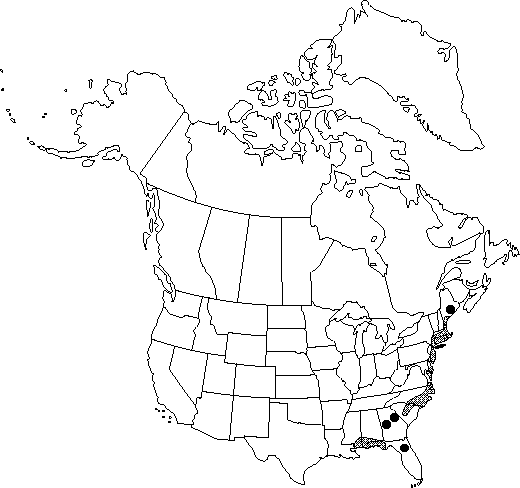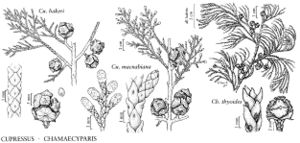Difference between revisions of "Chamaecyparis thyoides"
Prelim. Cat. 71. 1888.
FNA>Volume Importer |
imported>Volume Importer |
||
| (7 intermediate revisions by 2 users not shown) | |||
| Line 8: | Line 8: | ||
}} | }} | ||
|common_names=Atlantic white-cedar;southern white-cedar | |common_names=Atlantic white-cedar;southern white-cedar | ||
| − | |basionyms={{Treatment/ID/ | + | |special_status={{Treatment/ID/Special_status |
| + | |code=F | ||
| + | |label=Illustrated | ||
| + | }}{{Treatment/ID/Special_status | ||
| + | |code=E | ||
| + | |label=Endemic | ||
| + | }} | ||
| + | |basionyms={{Treatment/ID/Basionym | ||
|name=Cupressus thyoides | |name=Cupressus thyoides | ||
|authority=Linnaeus | |authority=Linnaeus | ||
| + | |rank=species | ||
| + | |publication_title=Sp. Pl. | ||
| + | |publication_place=2: 1003. 1753 | ||
}} | }} | ||
|synonyms={{Treatment/ID/Synonym | |synonyms={{Treatment/ID/Synonym | ||
|name=Chamaecyparis henryae | |name=Chamaecyparis henryae | ||
|authority=Li H. L. | |authority=Li H. L. | ||
| − | }}{{Treatment/ID/Synonym | + | |rank=species |
| + | }} {{Treatment/ID/Synonym | ||
|name=Chamaecyparis thyoides subsp. henryae | |name=Chamaecyparis thyoides subsp. henryae | ||
|authority=(Li H. L.) E. Murray | |authority=(Li H. L.) E. Murray | ||
| − | }}{{Treatment/ID/Synonym | + | |rank=subspecies |
| + | }} {{Treatment/ID/Synonym | ||
|name=Chamaecyparis thyoides var. henryae | |name=Chamaecyparis thyoides var. henryae | ||
|authority=(Li H. L.) Little | |authority=(Li H. L.) Little | ||
| + | |rank=variety | ||
}} | }} | ||
|hierarchy=Cupressaceae;Chamaecyparis;Chamaecyparis thyoides | |hierarchy=Cupressaceae;Chamaecyparis;Chamaecyparis thyoides | ||
| Line 29: | Line 42: | ||
}}<!-- | }}<!-- | ||
| − | --><span class="statement" id="st- | + | --><span class="statement" id="st-undefined" data-properties=""><b>Trees </b>to 20(–28) m; trunk to 0.8(–1.5) m diam. <b>Bark</b> dark brownish red, less than 3 cm thick, irregularly furrowed and ridged. <b>Branchlet</b> sprays fan-shaped. <b>Leaves</b> of branchlets to 2 mm, apex acute to acuminate, bases of facial leaves often overlapped by apices of subtending facial leaves; glands usually present, circular. <b>Pollen</b> cones 2–4 mm, dark brown; pollen sacs yellow. <b>Seed</b> cones maturing and opening the first year, 4–9 mm broad, glaucous, bluish purple to reddish brown, not notably resinous; scales 5–7. <b>Seeds</b> 1–2 per scale, 2–3 mm, wing narrower than body.</span><!-- |
-->{{Treatment/Body | -->{{Treatment/Body | ||
| Line 35: | Line 48: | ||
|elevation=0–500 m | |elevation=0–500 m | ||
|distribution=Ala.;Conn.;Del.;Fla.;Ga.;Maine;Md.;Mass.;Miss.;N.H.;N.J.;N.Y.;N.C.;Pa.;R.I.;S.C.;Va. | |distribution=Ala.;Conn.;Del.;Fla.;Ga.;Maine;Md.;Mass.;Miss.;N.H.;N.J.;N.Y.;N.C.;Pa.;R.I.;S.C.;Va. | ||
| − | |discussion=<p>Li H. L. (1962) segregated some populations at the extreme southwestern limit of the species in Alabama, Florida, and Mississippi as Chamaecyparis henryae based on smoother bark, less flattened branchlets, lighter yellowish green foliage, steeper angle of leaf appression to the stem, more prominently keeled but less glandular leaves, and slightly larger cones, seeds, and seed wings. These features were contrasted with phenotypes found in the "northern and mid-Atlantic" populations, and Li proposed a relationship to C. nootkatensis rather than to C. thyoides. Preliminary comparison of herbarium material from the Southeast (including populations in Georgia and Florida) leads to retention of C. thyoides as a subtly variable complex with the imperfectly differentiated C. henryae at one end of the range.</p><!-- | + | |discussion=<p>Li H. L. (1962) segregated some populations at the extreme southwestern limit of the species in Alabama, Florida, and Mississippi as <i>Chamaecyparis</i> henryae based on smoother bark, less flattened branchlets, lighter yellowish green foliage, steeper angle of leaf appression to the stem, more prominently keeled but less glandular leaves, and slightly larger cones, seeds, and seed wings. These features were contrasted with phenotypes found in the "northern and mid-Atlantic" populations, and Li proposed a relationship to <i>C. nootkatensis</i> rather than to <i>C. thyoides</i>. Preliminary comparison of herbarium material from the Southeast (including populations in Georgia and Florida) leads to retention of <i>C. thyoides</i> as a subtly variable complex with the imperfectly differentiated C. henryae at one end of the range.</p><!-- |
--><p>A. J. Rehder (1949) listed, with bibliographic citations, 30 published varieties and forms best considered as cultivars.</p> | --><p>A. J. Rehder (1949) listed, with bibliographic citations, 30 published varieties and forms best considered as cultivars.</p> | ||
|tables= | |tables= | ||
| Line 45: | Line 58: | ||
-->{{#Taxon: | -->{{#Taxon: | ||
name=Chamaecyparis thyoides | name=Chamaecyparis thyoides | ||
| − | |||
|authority=(Linnaeus) Britton | |authority=(Linnaeus) Britton | ||
|rank=species | |rank=species | ||
| Line 58: | Line 70: | ||
|publication title=Prelim. Cat. | |publication title=Prelim. Cat. | ||
|publication year=1888 | |publication year=1888 | ||
| − | |special status= | + | |special status=Illustrated;Endemic |
| − | |source xml=https:// | + | |source xml=https://bitbucket.org/aafc-mbb/fna-data-curation/src/2e0870ddd59836b60bcf96646a41e87ea5a5943a/coarse_grained_fna_xml/V2/V2_241.xml |
|genus=Chamaecyparis | |genus=Chamaecyparis | ||
|species=Chamaecyparis thyoides | |species=Chamaecyparis thyoides | ||
| − | |||
| − | |||
| − | |||
| − | |||
| − | |||
| − | |||
| − | |||
| − | |||
| − | |||
| − | |||
| − | |||
| − | |||
| − | |||
| − | |||
| − | |||
| − | |||
| − | |||
| − | |||
| − | |||
| − | |||
| − | |||
| − | |||
| − | |||
| − | |||
| − | |||
}}<!-- | }}<!-- | ||
-->[[Category:Treatment]][[Category:Chamaecyparis]] | -->[[Category:Treatment]][[Category:Chamaecyparis]] | ||
Latest revision as of 20:22, 5 November 2020
Trees to 20(–28) m; trunk to 0.8(–1.5) m diam. Bark dark brownish red, less than 3 cm thick, irregularly furrowed and ridged. Branchlet sprays fan-shaped. Leaves of branchlets to 2 mm, apex acute to acuminate, bases of facial leaves often overlapped by apices of subtending facial leaves; glands usually present, circular. Pollen cones 2–4 mm, dark brown; pollen sacs yellow. Seed cones maturing and opening the first year, 4–9 mm broad, glaucous, bluish purple to reddish brown, not notably resinous; scales 5–7. Seeds 1–2 per scale, 2–3 mm, wing narrower than body.
Habitat: Bogs and swamps of the Atlantic and Gulf coasts (primarily Coastal Plain)
Elevation: 0–500 m
Distribution

Ala., Conn., Del., Fla., Ga., Maine, Md., Mass., Miss., N.H., N.J., N.Y., N.C., Pa., R.I., S.C., Va.
Discussion
Li H. L. (1962) segregated some populations at the extreme southwestern limit of the species in Alabama, Florida, and Mississippi as Chamaecyparis henryae based on smoother bark, less flattened branchlets, lighter yellowish green foliage, steeper angle of leaf appression to the stem, more prominently keeled but less glandular leaves, and slightly larger cones, seeds, and seed wings. These features were contrasted with phenotypes found in the "northern and mid-Atlantic" populations, and Li proposed a relationship to C. nootkatensis rather than to C. thyoides. Preliminary comparison of herbarium material from the Southeast (including populations in Georgia and Florida) leads to retention of C. thyoides as a subtly variable complex with the imperfectly differentiated C. henryae at one end of the range.
A. J. Rehder (1949) listed, with bibliographic citations, 30 published varieties and forms best considered as cultivars.
Selected References
None.
